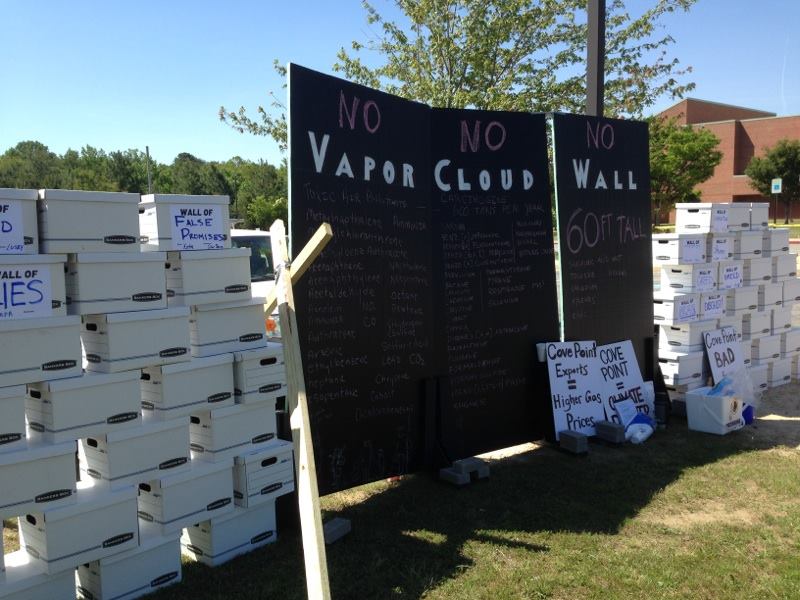For Immediate Release
Saturday, May 31, 2014
Contact:
Mike Tidwell, Chesapeake Climate Action Network, 240-460-5838, mtidwell@chesapeakeclimate.org
Tracey Eno, Calvert Citizens for a Healthy Community, 443-624-8022, traceyeno@comcast.net
Marylanders Demand Safety Answers at Contested Federal Hearing on Proposed Cove Point LNG Export Project
Citizens charge that federal regulators are selling out their safety by refusing to conduct a credible human risk assessment of explosion and fire dangers
LUSBY, Md.—Hundreds of citizens from Calvert County and across Maryland packed the Patuxent High School auditorium in Lusby on Saturday to protest what they call a shoddy and starkly insufficient federal review of the controversial proposed liquefied natural gas (LNG) export facility at Cove Point. The public meeting constituted Marylanders’ only confirmed opportunity to respond in person to the Federal Energy Regulatory Commission’s (FERC) draft “Environmental Assessment” of Dominion Resources’ $3.8 billion plan. Activists estimated that the testifiers, who stretched across more than six hours, spoke in opposition to the project, or for a more thorough Environmental Impact Statement, by a nearly 2-1 margin.
During testimony delivered inside, and through the construction of a large replica “vapor cloud wall” outside, Maryland residents living closest to the proposed gas liquefaction facility decried the absence of a credible federal study of the project’s human safety threats. On the wall, local residents listed the numerous types of toxic air emissions and carcinogens that could escape from the facility. They also attached notes expressing what Dominion’s proposed 60-foot-tall, three-quarter-mile long barrier wall symbolizes to them—from “greed” to “pollution” to “deception” to “harm.”


“By refusing to even conduct a basic safety study, FERC officials are essentially saying that the gas industry’s money and power matters more than our health and safety,” said Tracey Eno, a member of Calvert Citizens for a Healthy Community who lives 1.5 miles from the Dominion facility. “Dominion and the Calvert County Commissioners have shown all along that they don’t want the public to know the truth, and FERC is now complicit in their agenda. We need the whole picture, the actual, measurable risk to our lives and homes from a potential flammable vapor cloud or fire catastrophe, as part of a full Environmental Impact Statement. Anything less would be unconscionable, and unacceptable.”
Among many glaring gaps in FERC’s draft analysis, released on May 15, is the absence of a basic “Quantitative Risk Assessment” of the potential for fire or explosion catastrophes to endanger the 2,473 people living within a one-mile radius of the facility. If approved, Cove Point would be the only LNG export facility ever built within several hundred feet of residential communities. Yet FERC relies largely on Dominion’s own data and points to untested mitigation measures—like a proposed vapor cloud containment wall—to dismiss local residents’ concerns.
People traveled from all corners of Maryland on Saturday, donning red and wearing “No Cove Point Exports” stickers. A constant theme of testimony was the need for a full Environmental Impact Statement that addresses not only the project’s immediate safety risks, but also its role in speeding fracking and climate change—impacts that FERC also dismissed without substantive review.
The Cove Point facility would take gas from fracking wells across Appalachia, liquefy it, and ship it to customers in Japan and India.
View a briefing paper on the many deficiencies of the draft federal Environmental Assessment.
Statements from groups opposed to the LNG export project include:
“To conclude that Cove Point will have ‘no significant impact’ after the slapdash environmental study FERC just Jerry-rigged is outrageous,” said Jorge Aguilar, southern region director for Food & Water Watch. “It strains credulity to believe Cove Point will have ‘no significant impact’ on the safety of residents, or the pollution of our Bay waters, or fracking in Maryland’s gas basins, or even on climate change, which is what FERC now wants Marylanders to think. Clearly, FERC needs to prioritize protecting Maryland residents with a full environmental impact analysis instead of endangering all of us with sloppy, inadequate studies.”
“FERC won’t do a safety study for this controversial gas export plant, but it wants the people of Calvert County to believe it’s safe anyway. It’s not,” said Mike Tidwell, director of the Chesapeake Climate Action Network. “FERC won’t quantify the cumulative global warming pollution of the plant, but it asks us to believe there’s ‘no significant impact’ on the environment. We need a safety analysis and climate pollution analysis—or this export facility will never be legitimate.”
“The Federal Energy Regulatory Commission failed us in its review-lite of Dominion’s proposed fracked-gas export facility,” said Elisabeth Hoffman, a member of Howard County (HoCo) Climate Change. “FERC summarily dismissed all the harms of this project from fracking, piping and compressing gas all over our land and waterways. If FERC conducted its highest level of review and bothered to calculate the damage to our health, economy, environment and climate from fracking millions of metric tons of gas a year to ship to Asia, this project would not be approved.”
“This is a bad deal for the health of Maryland’s citizens,” said Dr. Gina Angiola, Board Member, Chesapeake Physicians for Social Responsibility. “It is bad for the quality of our air and our water, and it will hurt consumers by causing energy prices to rise. We are especially concerned about locating a natural gas export facility within three miles of a nuclear power plant. The effects of an explosion at Cove Point could potentially be catastrophic.”
###





